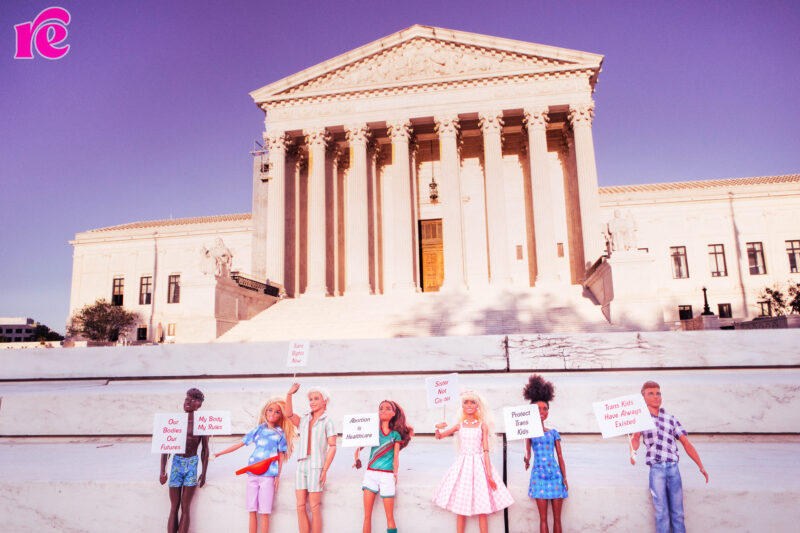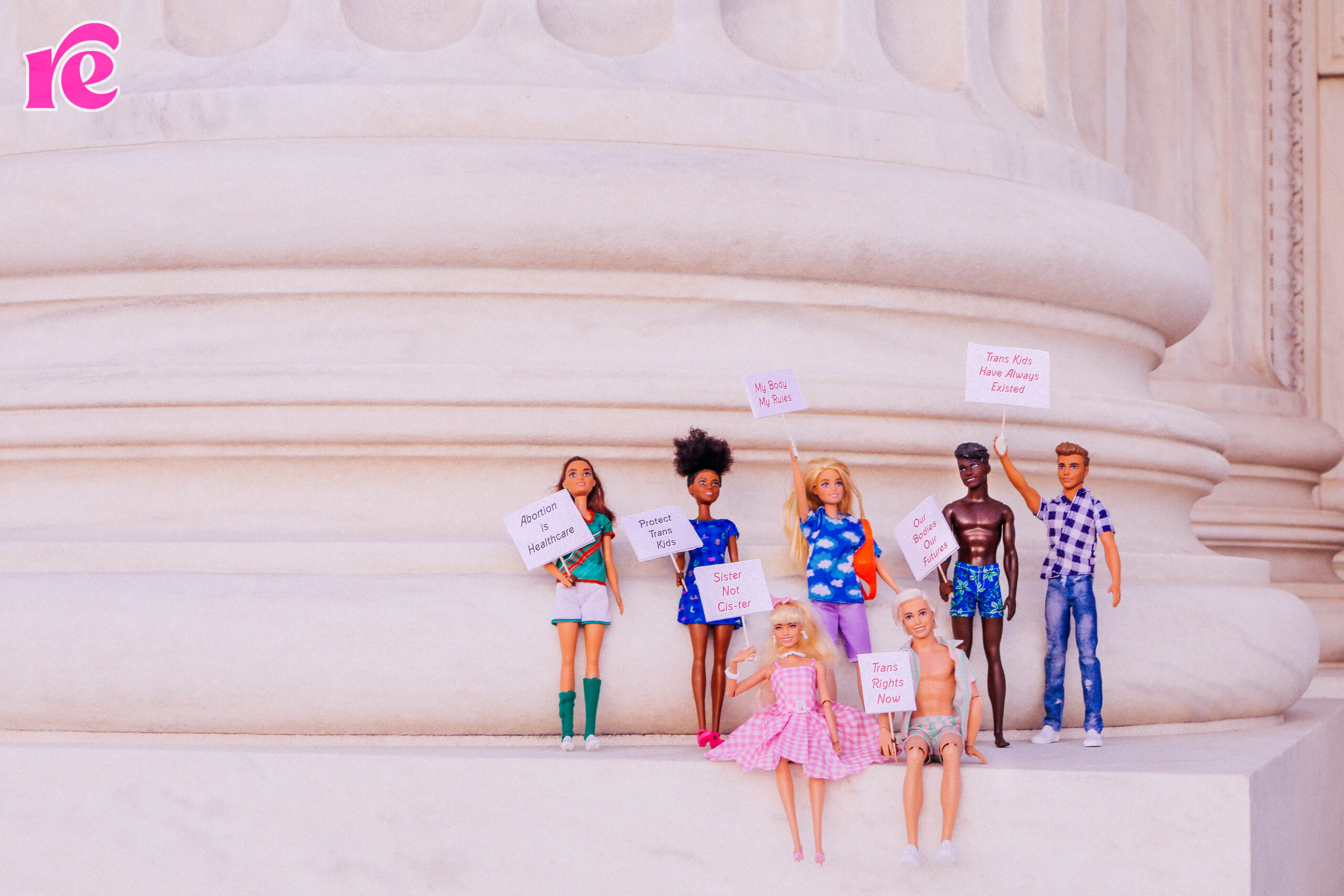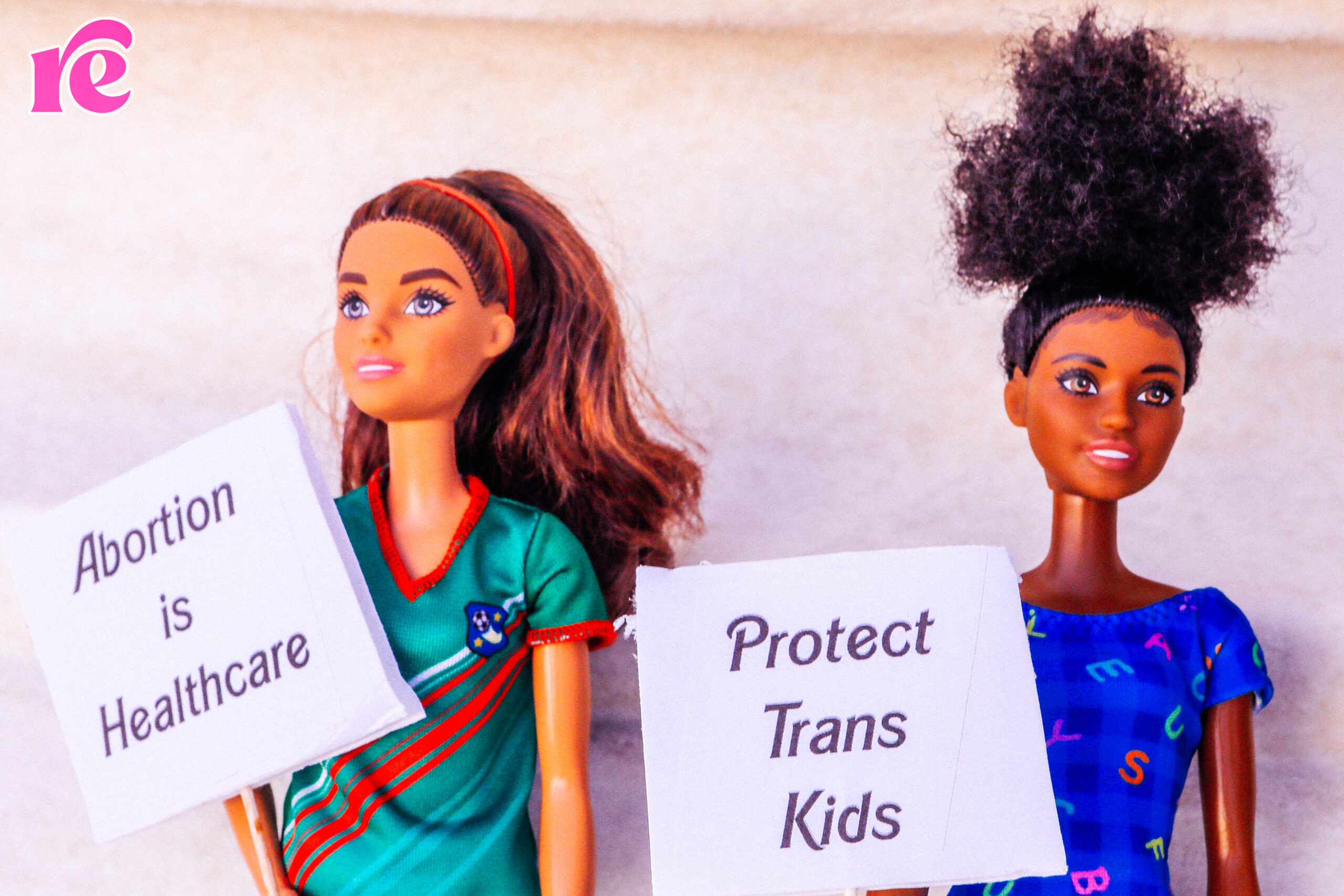Here’s One Thing the Constitution Could Do to Protect Trans People
The equal protection clause of the Constitution must respond to the rabid anti-trans sentiment in the country. If it cannot, it is worthless.

For related stories, check out our special issue, “They the People.”
Anti-trans bigotry, which at one point seemed to be disfavored, has come roaring back over the last couple of years as conservatives’ primary means of outrage politics. Across the country, parents have been whipped up into a frenzy about drag queens, rainbow flags, and pronouns.
No one is safe. Not RuPaul. Not even Mrs. Doubtfire. No longer beloved pop icons among the rabid right, both have become mere symbols of the “woke” ideology conservatives insist is destroying this country.
Anti-trans bigotry, fueled by a white nationalist agenda that can no longer point to the abortion boogeyman under the bed, has overwhelmed right-wing Christian evangelicals along with those—some of whom are on the left—who cater to them.
There are many examples. Supreme Court Justice Ketanji Brown Jackson was grilled during her confirmation hearing by smug insurrectionist Josh Hawley who thought asking “what is a woman?” was a gotcha question. Conservatives burned Bud Light in effigy for partnering with trans influencer Dylan Mulvaney. Mulvaney, a frequent target of the right, was previously savaged in the media for saying that she carries tampons in her purse for other women. The horror! And rainbow shirts at Target sparked a boycott and allegations that the retailer was participating in the grooming of children with its nefarious Pride collection.
It’s tempting to roll one’s eyes at conservatives’ tantrums and dismiss it as the backlash to post-Trump politics. Their fear of Gen Z voters is palpable—after all, young voters are often more tolerant than their parents, and some of them will be voting for the first time in 2024, an election that Republicans have seemingly decided to make about “woke gender ideology run amok.” And while I do believe that, ultimately, this period of time and the people who fomented it will be reviled, much in the same way we revile the white women who screamed at the little Black girls just trying to go to desegregated schools, the outrage fueled by pundits like Tucker Carlson, politicians like Florida Gov. Ron DeSantis, and pop culture figures like J.K. Rowling has nevertheless led to a dramatic shift in the legislative landscape. Laws that sparked outrage at the beginning of Donald Trump’s presidency are being enacted in droves in 2023.
All but three of 19 gender-affirming care bans were enacted this year, according to data from the Movement Advancement Project; six of those bans are slated to go into effect between now and 2024.

And with increasing attacks on trans people—on social media, legacy media, state legislatures, and in the courts—it seems that we as a society have a question to answer: Is animus against trans people a legitimate basis for lawmaking?
And if the answer to that question is no—as it must be—then perhaps it’s time for progressive legal scholars and advocates to begin a full-throttle discussion about rewriting, or, at least, unretconning, equal protection clause jurisprudence so that it fulfills not just its initial purpose: its originalist meaning, so to speak, which was protecting Black people from white racism, but also the spirit behind it, which was protecting marginalized groups.
Perhaps the public debate about whether discriminating against transgender people is acceptable under the Constitution can spark a larger debate about reframing the equal protection clause. Perhaps this debate can prompt a movement to stem the tide of white grievance complaints under the equal protection clause that anything that deprioritizes them is unfair and violation of the 14th Amendment, and to extricate ourselves from cerebral concerns about which state interests can be said to be compelling, thus triggering strict scrutiny, which can be said to be merely substantial, thus triggering intermediate scrutiny, and which can be said to be legitimate, thus triggering the easily surpassable rational basis review.
When I originally thought about writing this piece, I thought it would be a full-throated argument for the Supreme Court to recognize transgender people as a suspect class so that laws targeting them can be assessed accordingly. A protected or “suspect” class is made up of “discrete and insular minorities”: a group of people who have historically been subjected to discrimination, comprise a discrete minority (meaning there aren’t a lot of them, percentage-wise), and have immutable characteristics (meaning characteristics that cannot be changed).
Laws targeting suspect classes are subject to heightened judicial scrutiny in order to protect a tyrannical majority from sticking it to that “discrete and insular minority.” The trick for the courts has been determining what level of judicial scrutiny to apply.
But what if the various levels of judicial scrutiny are hurting more than helping the cause of marginalized people like the transgender community?
What if Black people’s history in this country of being discriminated against is being used as a glass ceiling when it comes to discrimination suffered by other groups of obviously marginalized people—like transgender people?
The Supreme Court’s equal protection analysis, more than any other Supreme Court jurisprudence, has tangible effects on the lives of people living at the margins of society and who are being actively erased from civil participation: Black people. LGBTQ+ people. Immigrants. People with disabilities. Native people. Pregnant people. Women. We all rely on the mealy-mouthed words Supreme Court justices have, over the years, concocted to describe us. We’re called a discrete and insular minority. We’re described as people with characteristics that are immutable (a categorization that for some reason includes religion, even though religion is not immutable; that is not to say that religious people don’t deserve protection under the equal protection clause, but it is to say that people frequently change their religion).
And after we are sorted and categorized into suspect or quasi-suspect classes, more mealy-mouthed words are used to determine whether laws that target us—and actively make it more difficult for us to participate in the democratic process—are constitutional: Compelling interest. Substantial interest. Legitimate rationale. Exceedingly persuasive justification.

How would the application of these mealy-mouthed words doing anything to stem the tide of anti-trans bigotry? How would traditional equal protection analysis end the anti-trans crusade masquerading as parental rights and concern for kids? Appellate courts are stalwartly avoiding any discussion of how to treat transgender people under the equal protection clause.
Even in the lawsuits challenging states’ discrimination in the delivery of health-care services against trans people—which is what gender-affirming care bans are—appellate courts seem reluctant to apply the vaunted levels of judicial scrutiny to transgender people even though they obviously fit the mold. Transgender people are a discrete and insular minority, and they lack political power, as evidenced by the avalanche of legislation targeting and dehumanizing them. And still, appellate courts seem squeamish about stepping in and calling a spade a spade. They seem loath to view discrimination against trans people as something in and of itself deserving separate equal protection analysis: They’d rather rely on proscriptions against discrimination on the basis of sex.
For example, in striking down Arkansas’ gender-affirming care ban, the Eighth Circuit Court of Appeals dropped a footnote saying it didn’t disagree with the lower court’s designation of trans people as a quasi-suspect class, but then said there was no need to get into a discussion about suspect classes: “We need not rely on it to apply heightened scrutiny because the Act also discriminates on the basis of sex.”
But what about the fact that the law discriminates against trans people as trans people? The laws may discriminate against them because of sex for constitutional analysis, but that’s not actually what’s happening here.
These laws and lawmakers are discriminating against transgender people qua transgender people.
Of course, conservatives will never admit that their campaign against trans existence has anything to do with malice. It’s about the children, you see. Banning drag shows—even drag shows that have been created and performed for children for decades—is necessary because they dimly believe that drag queens are groomers and predators. (Never mind that the calls about groomers and predators are coming from inside the missionary, with news stories daily about youth pastors being convicted for sex crimes. Banning puberty blockers is supposedly about knowing what’s best for trans kids more than they themselves, their parents, or doctors do.
But in their most honest moments, even conservatives cannot keep the malice at bay. In passing Florida’s gender-affirming care ban, for example, one of the legislators went on record and referred to trans people as “mutants” and “demons.”
But they’ll dismiss such comments as outliers as they continue to make the nonsensical case that their campaign is about protecting kids and parents’ rights to keep their kids safe from the existential threat of rainbows and pronouns. But that doesn’t make any sense, does it? How can it be about parents’ rights when they’re denying parents the right to make decisions about their trans kids’ health care?
The frenzy with which these laws have been packaged and passed tells a tale of a desperate effort to implement a Christian nationalist agenda through the systematic erasure of trans people from civic society.
We watched this summer as the Supreme Court embarked on its mission to rewrite the equal protection clause of the 14th Amendment so that it protects white people. Racial classifications, irrespective of context, are an anathema to our colorblind Constitution, it seems.
If their mission is successful, then the equal protection clause won’t protect anyone but white people. If the pro-Black amendment—the amendment intended to protect Black people and expanded to protect marginalized people—no longer protects the people it was intended to, it can’t protect trans people. That’s because there’s a difference between equality and equity. Equality demands that we ignore race. Equity demands that we take race into account in context on a case-by-case basis.

And equity would demand that we stop holding up racial discrimination as the lodestar of discrimination, thereby drawing attention away from other equally virulent forms of discrimination. Equity would demand that we dispatch concerns about quasi-suspect classes or suspect classes and look at discrimination against individual groups based on the context of that discrimination and the animus with which that discrimination is implemented. This kind of approach would demand that appellate courts and federal law protect transgender people.
Reva Siegel, a professor at Yale University School of Law has written the following:
It is now commonplace to condemn slavery and segregation—a rhetorical practice presumably intended to bind Americans ever more closely to principles of equality. But repeated condemnation of slavery and segregation may have just the opposite effect. We have demonized subordinating practices of the past to such a degree that condemning such practices may instead function to exonerate practices contested in the present, none of which look so unremittingly ‘evil’ by contrast.
Michael Gentithes, a professor at University of Akron School of Law, elucidates the point:
The equal protection clause should protect against discrimination based upon immutable characteristics regardless of whether any case involving such discrimination has previously been litigated or whether that particular form of discrimination has become prevalent only recently. In other words, the clause should respond to more than history; it must be strong enough to protect against novel forms of discrimination that may arise in the future.
The equal protection clause has to respond to the rabid anti-trans sentiment that has gripped the country and is starting to take hold, as evidenced by the Sixth Circuit’s ruling in July in L.W. v. Skrmetti that upheld Tennessee’s gender-affirming care ban. The ruling provides the precise legal arguments the Supreme Court could hang its proverbial hat on to uphold a gender-affirming care ban next term because, as Ian Millhiser wrote for Vox, the author of the opinion, Judge Jeffrey Sutton, isn’t an extremist; he’s a Republican’s Republican.
It wasn’t long ago that the country damn near revolted when North Carolina passed its trans bathroom ban. But that was before anti-trans bigotry became big business and before it became the lynchpin of the conservative movement. (It used to be abortion. But conservatives won that fight. Now? It’s trans people.) The NCAA threatened to pull games from the state and ultimately, the North Carolina Legislature backed down. That was 2017.
It’s six years later, and states are behaving as if the trans people they mostly ignored are some sort of national security threat. The amped up nature of the anti-trans attacks are palpable. And if the equal protection clause of the 14th Amendment cannot rise to meet this moment, then it is worthless.
CORRECTION: An earlier version of this story misspelled Michael Gentithes’ name.
